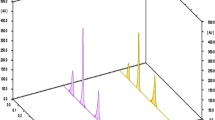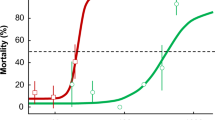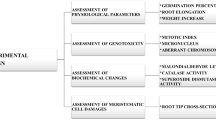Abstract
DIMETHOATE (O,O - dimethyl S - (N - methylcarbamoylmethyl) phosphorodithioate) is an effective systemic insecticide for use on plants1–3, has shown promise as a chemotherapeutic agent for control of cattle grubs4,5 and certain other insect pests of farm animals, and has high contact toxicity to house-flies and many other insects. The pure material, with a rat oral LD50 of about 600 mgm./kgm., is the least toxic to mammals of the systemic insecticides at present available for use in controlling plant pests. Commercial dimethoate is 2–4 times more toxic to rats than the pure compound, and repeated recrystallization or chromatography is required to achieve the reduced mammalian toxicity of the pure material. Several investigations have been reported on the chemical6 and biological7–9 degradation of dimethoate.
This is a preview of subscription content, access via your institution
Access options
Similar content being viewed by others
References
Santi, R., and de Pietri-Tonelli, P., Nature, 183, 398 (1959); and Richerche sul meccanismo d'azione della N-monometilammide dell'-acido O, O-demetilditio-fosforilacetico. Montecatini, Milano, Italy, Bull., 29 pp. (1959).
Geering, Q. A., World Crops, 11, 141 (1959).
American Cyanamid Co., Stamford Conn, U.S.A., Dimethoate (E.I. 12,880) Bull., 35 pp. (1959).
Hewitt, R., Brebbia, A., and Waletzky, E., J. Econ. Entomol. 51, 126 (1958).
Hewitt, R., Emro, J., Entwistle, J., Pankavich, J., Thorson, R., Wallace, W., and Waletzky, E., J. Econ. Entomol., 51, 445 (1958).
Fontanelli, R., and Lanforti, G. F., Rend. ist. super. sanità, 22, 32 (1959).
Dauterman, W. C., Casida, J. E., Knaak, J. B., and Kowalczyk, T., J. Agric. Food Chem., 7, 188 (1959).
Kaplanis, J. N., Robbins, W. E., Darrow, D. I., Hopkins, D. E., Monroe, R. E., and Treiber, G., J. Econ. Entomol., 52, 1190 (1959).
Dauterman, W. C., Viado, G. B., Casida, J. E., and O'Brien, R. D., J. Agric. Food Chem., 8, 115 (1960).
Seume, F. W., and O'Brien, R. D., Toxicol. App. Pharmacol., 2, 495 (1960).
Author information
Authors and Affiliations
Rights and permissions
About this article
Cite this article
CASIDA, J., SANDERSON, D. Toxic Hazard from formulating the Insecticide Dimethoate in Methyl ‘Cellosolve’. Nature 189, 507–508 (1961). https://doi.org/10.1038/189507a0
Issue Date:
DOI: https://doi.org/10.1038/189507a0
Comments
By submitting a comment you agree to abide by our Terms and Community Guidelines. If you find something abusive or that does not comply with our terms or guidelines please flag it as inappropriate.



